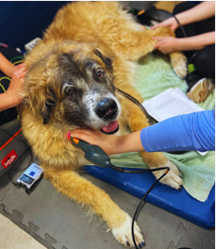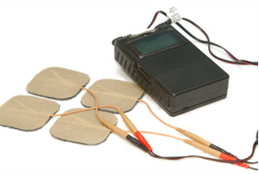Jul 02, 2024

Physical rehabilitation in veterinary medicine is similar to physical therapy in people. With the goal of improving a pet’s physical mobility, comfort, and quality of life, veterinary rehabilitation combines therapeutic exercise, hands-on manual therapies, and modalities like hydrotherapy (underwater treadmill). Rehabilitation can also facilitate recovery from injury or surgery and even condition canine athletes. Read on to learn why senior pets in particular benefit from physical rehabilitation.
1. In older pets, decreased mobility and increased pain are extremely common but hard to recognize.
As they get older, dogs and cats may face mobility challenges. The symptoms of these challenges are often attributed to and accepted as “old age” or “slowing down.” The signs may develop so gradually that they can be hard to notice. The following may indicate that your senior pet is suffering from decreased mobility and could benefit from a rehabilitation program:
Signs of decreased mobility and discomfort can be subtle, and they often overlap. Some pets may have an obvious limp or vocalize to indicate they are painful. Chronic pain, like pain from arthritis, may be harder to detect. Chronic pain may look like a loss of interest in normal activities, less willingness to play, decreased quality interactions with family members and other household pets, and in some cases increased aggression.
If you are concerned your pet is in pain, but aren’t sure where to start, contact us.
2. Arthritis is pervasive in old dogs and cats, and medications may not be enough.
An estimated 40% of all dogs and 90% of cats over age 12 have osteoarthritis,1,2,3 a painful and debilitating degenerative joint condition. While osteoarthritis can be partially managed with medications, senior pets often have chronic medical conditions that limit the medications they can safely take, making effective pain management more challenging. Physical rehabilitation offers non-pharmaceutical options for pain management that go beyond what medications can do by improving mobility, strength, and comfort without side effects. This can be especially helpful if your pet cannot take certain medications because of an underlying illness, has sensitivities to medications, or is experiencing pain despite their current medication protocol.
Advancements in veterinary anesthesia and surgery allow us to safely treat many conditions, even in older pets. For example, orthopedic surgery, such as the TPLO, is not just for young dogs anymore. Incorporating postoperative rehabilitation can help the body heal more effectively and efficiently, which is especially helpful for senior pets who may not heal as quickly as they once did.
Just like in people, maintaining muscle mass in pets is extremely important for maintaining good mobility. Rehabilitation encompasses several treatment modalities, from electrical muscle stimulation to underwater treadmill, that work to build strength in senior pets. The exercise provided by a rehabilitation program can also support weight loss or maintenance of a healthy weight.
Normal daily activities like standing at the food bowl, coming to greet you at the door, and getting in or out of bed can be big hurdles for our older companions. By improving mobility, strength, comfort, and healing, physical rehabilitation can help your pet more comfortably navigate these everyday tasks. Furthermore, with the gains from a rehabilitation program, senior pets may once again enjoy their favorite activities, such as long walks and gentle hikes. A return to favorite activities means more quality time spent between you and your senior pet. In addition to helping pets become stronger, home exercise programs encourage mental stimulation and create even more opportunities for you to bond with your pet.
Instead of relying on medications to do all the work, rehabilitation offers a variety of treatment modalities to holistically treat senior pets:

Acupuncture: Acupuncture involves the placement of thin needles into the skin at distinct anatomic locations to stimulate nerve endings, release endorphins, and promote the body’s natural healing response. It is a Traditional Chinese Medicine technique that has been used for thousands of years, and modern medicine has confirmed its efficacy with peer-reviewed scientific studies. This treatment modality can be used to manage pain and improve mobility, particularly for arthritis, intervertebral disc disease, and other neurologic disorders.

Laser therapy: Laser therapy is the application of certain wavelengths of light to reduce pain and inflammation and stimulate cellular repair to accelerate healing. This modality is useful for the management of musculoskeletal and neurologic conditions. It is also used after surgery to promote the healing of incisions and underlying structures.

Neuromuscular electrical stimulation: Both Electrical Muscle Stimulation (E-stim) and Transcutaneous Electrical Nerve Stimulation (TENS) are techniques that apply electric currents to specific areas of the body. E-stim applies electric currents to muscles, which causes them to contract, thereby supporting muscle growth and strength. With TENS, the electric signals are applied to painful areas to “confuse” or disrupt pain signaling. In this way, TENS works to relieve pain, particularly that associated with arthritis and nerve pain.

Manual therapy to joints: Manual traction, compression, and mobilization applied to aging joints work to improve their mobility, strength, stability, and comfort.

Underwater treadmill: As your pet ages, high-impact exercises like hiking and fetch may become painful or result in residual soreness. However, senior pets still need exercise for physical and mental stimulation. The buoyancy and added resistance afforded by hydrotherapy provide a low-impact exercise that helps improve muscle strength, joint range of motion, and cardiovascular fitness. These benefits also allow senior pets to go on to enjoy other physical activities once again.

Mobility support devices: Mobility support devices, such as braces, specialized harnesses, and wheelchairs, can provide extra mobility support for senior pets who struggle with rising and/or walking. The goal of these tools is to allow pets to maintain their mobility and continue to lead active lives.

Massage therapy: Just like in people, manual manipulation of soft tissues promotes relaxation, improves circulation, and relieves muscle tension, pain, and soreness. Massage therapy may also be part of a home care program to extend the beneficial effects between sessions.
Individualized programs created by our Certified Canine Rehabilitation Therapists (CCRTs) consist of massage, stretching, and therapeutic exercise to maintain your pet’s hard-earned progress through their rehabilitation journey. Home care exercises allow for consistency so that we can accelerate the process and ensure the best possible outcome. With comprehensive instructions and demonstrations, a prescribed home rehabilitation program empowers you to enhance your pet’s mobility, comfort, and bond with your family.
When you arrive for a consultation, a member of our rehabilitation team will first meet with you to discuss your pet’s medical history and your goals for the visit. She will then escort your pet to our rehabilitation room where we do all our patient evaluations and treatments.
A rehabilitation examination involves evaluating your pet’s mobility, pain level, strength, range of motion, and flexibility. Once our rehabilitation doctor has completed the evaluation, she will thoroughly explain her findings, recommendations, goals, and expectations specific to your pet. Typically, the consultation appointment lasts 60-90 minutes.
In most cases, we can start selecting rehabilitation treatments on the day of the initial consultation. If your pet is shy or painful, we may start slowly because it is important that we make rehabilitation a safe and comfortable experience. In some cases, more diagnostic testing is recommended prior to starting treatments so that we can provide your pet with the appropriate care.
At AESC, treatment costs range from $65-$295 per visit, depending on the treatment provided and the level of care your pet needs. The number and frequency of visits we recommend will also vary depending on what is realistic for your schedule and budget, your pet’s current physical ability and level of pain, and our collective goals for your pet. Our team will thoroughly review all options and recommendations with you at the time of your consultation.
The rehabilitation team at AESC is led by veterinarians who are also Certified Canine Rehabilitation Therapists (CCRTs). In addition to their specialized training in rehabilitation, they also hold certifications in acupuncture. As veterinarians, they can diagnose conditions and prescribe medications when indicated. The team also collaborates with AESC’s board-certified specialists in surgery, anesthesiology, neurology, radiology, oncology, internal medicine, and critical care to get pets the expertise they need.
At AESC, we have helped hundreds of senior pets overcome the discomfort of arthritis and the challenges of aging. Our experienced team provides customized treatment plans that treat each pet's unique needs and symptoms. Our rehabilitation programs aim to build strength, improve mobility, and reduce pain, ultimately helping older dogs and cats regain independence, bond with their families, and enjoy a higher quality of life.
If you are ready to pursue rehabilitation for your senior pet, please contact us to make an appointment.